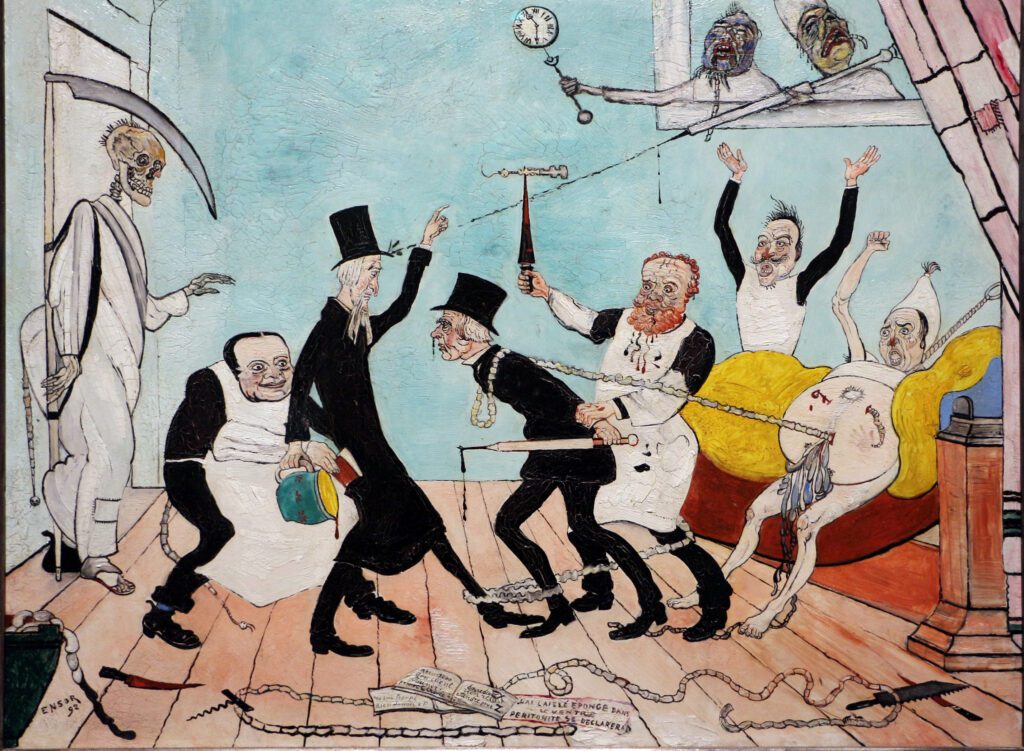Howard Fischer
Uppsala, Sweden

“Je crois être un peintre d’exception.” (I believe myself to be an exceptional painter.)1
– James Ensor
The Belgian artist James Ensor (1860–1949) used his paintings as social criticism. He despised the church, courts, judges, lawyers, art critics, civil authorities, and doctors.2 He saw them as self-satisfied members of an elite that ignored the problems of workers. His generation of artists produced “decadent art.” In English, decadent connotes moral decline, but the French word décadent reflects its Latin origin, decadentia, meaning “to decay.” Decadent art uses themes of learned experience “transcended into disgust, either by producing “disgusting” images, or by attempting to induce disgust within a given social issue.”3
Ensor’s 1892 painting The Bad Doctors (Les Mauvais Médecins)4 shows a group of five doctors involving a patient in a scene of “utter carnage.” A top-hatted doctor drags a tapeworm from the swollen, scarred abdomen of the patient, who screams in agony as his abdominal viscera protrude. A surgeon in a bloody gown holds up the tapeworm’s head on a spike. Another doctor, possibly drunk, carries an empty pot dripping blood, while his pocket gets picked by a colleague. Coils of tapeworm are everywhere; the floor is bloody; and saws, knives, and corkscrews litter the place. In one version (1895) of this painting, the tapeworm re-enters the patient.5
Two decomposing cadavers, one holding an enema syringe, look on from a window. A fifth doctor “throws his arms up in horror.” Death, in a patched toga, stands ready, reminding us of the connection between medical practice and death.6 In the foreground there are “some scattered clinical notes”7: “Woman C croaked at 7 o’clock. Received 1000.” “Dispatch X. Nothing received. Wait for Z.” “Made a mistake. Nothing given to P.” “I left a sponge in the abdomen. Peritonitis will happen.” This is from an 1895 etching.
The five doctors in the painting are the “most brilliant” members of the faculty of medicine at the Free University of Brussels, professors of anatomy, histology, zoology, or surgery.8 Ensor never met any of the five. He used them only because of their prestige at the university.
The 1892 painting was exhibited in Brussels in 1893. It was then bought by a physician (not one of the five pictured), then given (or willed) to another physician, and then to another. It was hidden during World War Two, and after the death of the third owner, it was given to the Free University of Brussels. It was exhibited for the second time in Antwerp, Belgium in 1992.9 Ensor, an “eternal hypochondriac,” did not think much of doctors, who were not able to “cure” him.10 He disliked the medical profession and “the whole social class to which it belongs.”11
References
- Bart Verschaffel. “The sources of James Ensor’s grotesques: The encyclopédie de la caricature by Jules Champfleury.” Academia. https://www.academia.edu/30892420/The_sources_of_James_Ensors_grotesques_the_Encyclop%C3%A9die_de_la_caricature_by_Jules_Champfleury.
- Christine Bluard. “James Ensor et les Médecins.” Histoire des Sciences Médicales, 32(2), 1998. https://www.biusante.parisdescartes.fr/sfhm/hsm/hsmx1998x032x002/hsmx1998x032x002x0129.pdf.
- Kaylee Alexander. “Descent from the cross: James Ensor’s portrait of the symbolist artist.” Shift: Graduate Journal of Visual and Material Culture, 2017. Academia. https://www.academia.edu/38215375/Descent_from_the_Cross_James_Ensors_Portrait_of_the_Symbolist_Artist.
- Mike McKiernan. “James Ensor, The Bad Doctors 1892.” Occupational Medicine, 63(7), October 2013.
- Patrick Reuterswärd. “Kommentarer till de enskilda verken. De dåliga doctorena.” In En liten bok om Ensor, Stockholm: Nationalmuseum, 1970.
- Musée de Beaux Arts de Gand. “Les Mauvais Médecins, 1895.” https://www.mskgent.be/fr/collection/1998-b-97-1.
- Wellcome Collection. “Evil doctors maltreating a patient. Etching by James Ensor, 1895.” https://wellcomecollection.org/works/g7dtpcd9.
- Bluard. “James Ensor.”
- Bluard, “James Ensor.”
- Bluard, “James Ensor.”
- Astrid Herkens. “Edmond Picard et James Ensor.” Textyles, 50-51, 2017. https://journals.openedition.org/textyles/2778.
HOWARD FISCHER, M.D., was a professor of pediatrics at Wayne State University School of Medicine, Detroit, Michigan and has long appreciated Belgian artists.

Leave a Reply